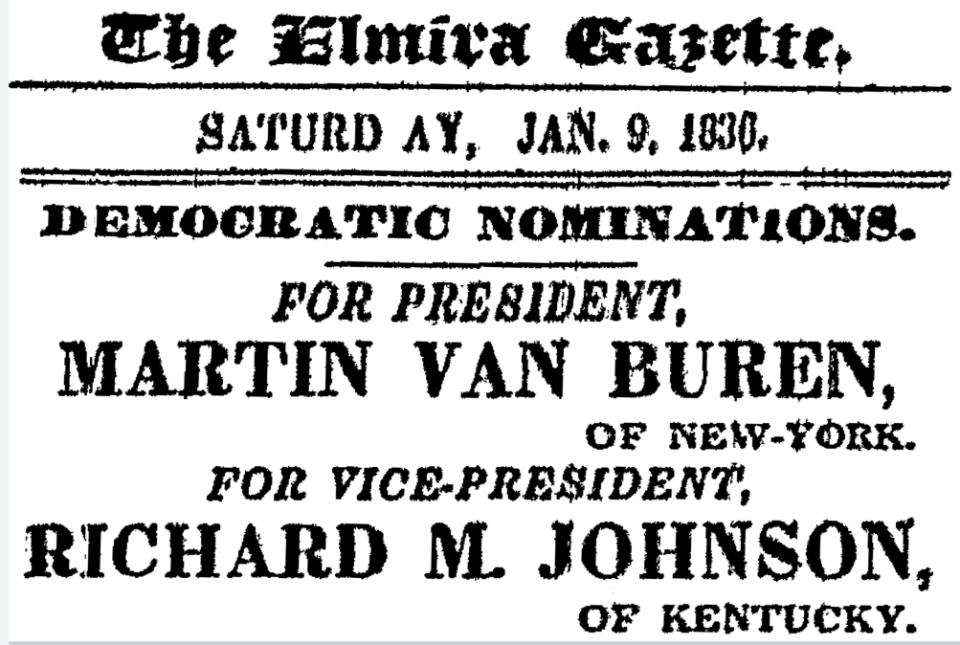Frigid temperatures, a lost wallet, a new toll bridge: Elmira headlines from January 1836
- Oops!Something went wrong.Please try again later.
What was going on in our area in January 1836? I will tell you some of the news from the Elmira Gazette.
Elmira was part of Tioga County. Chemung County had not yet been separated. That would come later that same year. The business section of Elmira in the 1830s was mainly between Baldwin and Lake Streets and both sides of Water, or River Street, as it was then called. There was one bridge at the south end of Lake Street.
The Elmira Gazette was a young newspaper published on Saturdays in Elmira. The subscription rate was $2 a year in advance. Some of our news was reprinted from the Albany Argus. J. A. Smith was the publisher.
Daniel Webster's editorial letter about the Anti-Masons of Pennsylvania was reprinted from the Pittsburgh Telegraph. The Anti-Masons were the earliest third party in the United States. It strongly opposed Freemasonry.
There was a long article from Washington, D.C., on the happenings in Congress that week. It was not interesting.
A New York [City] Star article about a massive fire in Hanover Square in NYC's financial district was reprinted. Losses were reported with 20,000 chests of tea, 12,000 bags of coffee, 3,000 boxes of Cuban sugar, 40,000 gallons of sperm oil, and a “large proportion” of brandy. Loss of property valued at $15 million, including French goods — silks, satins, and lace in a pile 60 feet wide by 25 feet high. “
A gust of flame came from the NE corner of the building, shooting across the square, blown by the strong wind, and set fire to the entire mass, which in a few moments consumed to cinders and then communicated to the house opposite.” A total of 527 buildings were destroyed.
There were 45 unclaimed letters at the local post office with a list of names asking for them to be picked up.

The Watertown, NY, thermometer reached 34 below zero on Jan. 17. There was no mention of Elmira’s temperature.
Elisha Perkins’ calf skin wallet was lost on “the night of Wednesday the 18” somewhere downtown. He hoped it would be returned.
A notice of application to build a toll bridge across the Chemung River near Brown’s Mills on the Elmira side to Sharp’s Mills on the Southport side was possible. The southside was known as Southport.
The Elmira Female Seminary was now in its winter term. Directly below that ad, Miss J. C. Hart’s School offered an education similar to the Elmira Female Seminary with specialty subjects in French and Latin if desired.
John Hendy had 250 acres of valuable timberland to sell “within six miles of the village of Elmira and 3 miles of water transportation.” The Chemung Canal opened three years earlier, in 1833, and connected Elmira to Seneca Lake, the Erie Canal, Buffalo, Rochester, Albany, and New York City.
In advertisements, Dr. T. White’s Vegetable Tooth-ache drops were available at J. Arnot & Co. I looked up this product and found it was still sold in the United States 103 years later.

Groceries on sale that week were loaf, lump and brown sugars, nutmeg, saleratus, cavendish tobacco, champagne, Madeira and Tenerife wines, codfish, mackerel, and horse blankets. All are available at Tuthill and Satterlee.
Saleratus was an old name for baking powder. According to Wikipedia, loaf sugar was a tall, molded cone that needed sugar nips to cut what one needed. Cavendish tobacco was heat-treated and pressured to “bring out the natural sugars." Tenerife wine came from the Canary Islands.
Archibald Heggie’s hat store offered “cash for sheep and lamb skins with the wool on. Also, Mink, Muskrat, Martin, Fisher, Otter, Fox, and Bear Skins.”
More: Horseheads church wins major battle in lawsuit against NYS over gun law restrictions
The Chemung Canal Bank’s hours were 9 a.m. - noon and 2-4 p.m. daily except Sunday.
There was no city directory, so I can’t look up these merchants or residents.
The Elmira Gazette merged with the Elmira Evening Star in 1907 and became the Star-Gazette.
-- Diane Janowski is the Elmira City Historian.
This article originally appeared on The Evening Tribune: Exploring Elmira history with headlines from January 1836

